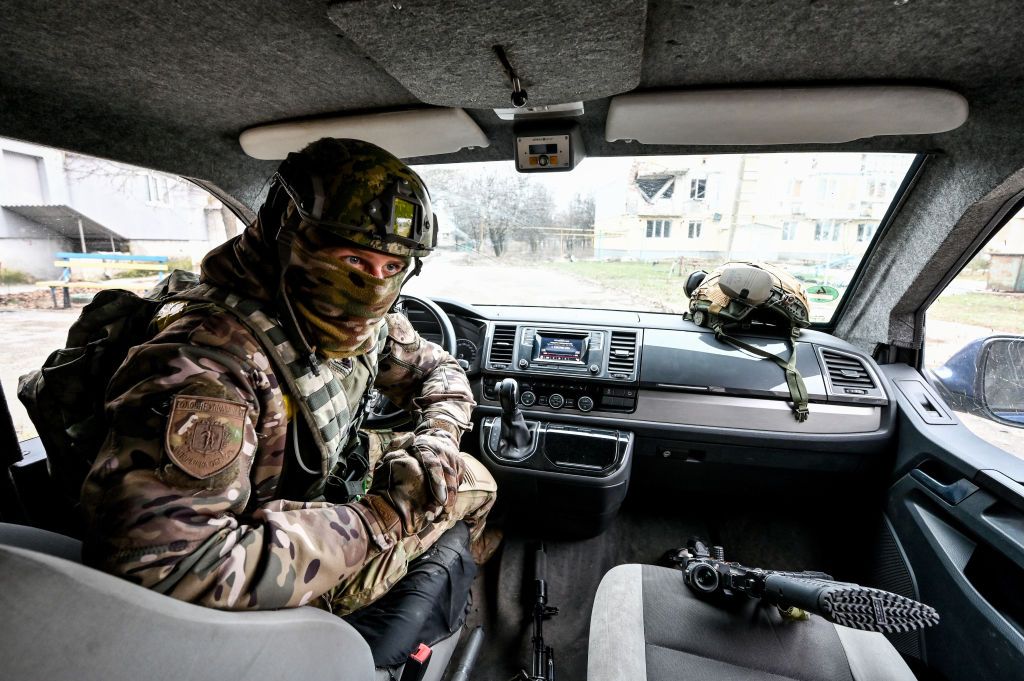Russia’s new guided bombs pose increasingly serious threat to Ukraine

Still unable to achieve air supremacy, Russia is nevertheless finding ways to threaten Ukraine from the sky.
Early this year, Russia introduced guided bombs — essentially, the regular gravity bombs modified to be dropped by multirole fighter-bombers from safe distances and deal precise and very damaging strikes in front-line areas and beyond.
Along with the specifically designed sophisticated smart munitions, Russia has been using the modified version of simple 500-kilogram air bombs that it has in vast numbers.
It poses an especially serious threat to Ukraine. By turning simple bombs into guided ones, Russia is unfolding a tactical weapon that is much cheaper, more massive, and more effective than cruise and ballistic missiles, the stockpile of which is largely depleted now. And it can at least partially substitute the lack of air support for its troops on the ground in Ukraine.
The use of Russian guided bombs already has a perceptible effect along the front line, particularly on the Ukrainian defenses of Avdiivka in Donetsk Oblast.
The Ukrainian Air Force calls this a dangerous situation. Russian guided bombs are launched from beyond the effective ranges of Ukrainian air defenses, and as of now, Ukraine has little to no instruments to counter them.
The Ukrainian air force again insists it must be provided with Western fighter jets operating modern longer-range air-to-air missiles — so that Ukrainian aircraft could push Russian carriers farther away from front lines beyond the effective range of their guided bombs and thus neutralize the threat.
Deploying new bombs
Overnight into March 24, the Ukrainian military reported a devastating air strike in Sumy Oblast. Russian aircraft dropped 11 munitions identified as 500-kilogram air bombs equipped with UMPK (“unified module for gliding and guidance”) systems.
The kit reportedly provides old and abundant Soviet FAB-500М-62 gravity bombs with a simple satellite guidance system and “wings.” According to Russian sources, the kit’s production cost is 2 million roubles ($24,000).
As a result of this modification, a simple bomb becomes a cheap substitute for an expensive guided missile carrying a 390-kilogram warhead. For comparison, a Kalibr cruise missile carrying a 450-kilogram warhead at a distance of up to 1,500 kilometers is worth nearly $6.5 million.
Upon Ukrainian air force estimates, such munitions launched from upper altitudes and at a high velocity can have an effective range of over 50 kilometers. As such, the bombs can deliver devastating hits upon Ukrainian lines and the rear front.
In particular, the FAB-500 family bombs, according to Amnesty International, were used by Russia in its devastating strike on the Mariupol Drama Theater in March 2022.
The accuracy rate of the bomb’s new smart version is unknown.
However, the cheapness of the modification and the abundance of FAB-500 bombs in the Russian military pave the way for extensive use in war zones.
According to Ukraine’s Air Force, up to 20 guided bomb hits are registered daily all along the front line, with Russian Sukhoi Su-34 and Sukhoi Su-35 jets used as carriers.
As of now, Russia has not admitted the serial production of UMPK kits.
Russian gliding smart bombs now go in comparison with U.S.-provided JDAM-ER bomb kits that Ukraine currently operates as well, with their effective range reaching up to 72 kilometers.
The mass deployment gives a go to bombs that are much more powerful than light guided KAB-20L or KAB-50S launched with Forpost drones, the licensed copy of Israeli IAI Searcher systems.
Moreover, even heavier and more advanced munitions have already been seen in use in Ukraine in 2023.
In March, Russian forces were also seen using munitions identified as 1,500-kilogram UPAB-1500B guided bombs in Avdiivka, which has become the target of devastating air strikes wiping away city blocks.
Russian UPAB-1500B smart bomb design is known since 2019. According to the manufacturer, the munition’s export version is capable of delivering a 1,010-kilogram warhead. The munition allegedly uses inertial and satellite guidance and navigation systems and has an accuracy rate of just 10 meters.
The manufacturer says the gliding bomb can be dropped at an altitude of up to 15 kilometers from a distance of up to 50 kilometers from the target, “which reduces the probability of the carrier being targeted by the adversary longer range air defenses.”
The UPAB-1500B can be used by 4++ or 5th generation aircraft, which in fact makes Sukhoi Su-34 fighter-bombers the munition’s sole carrier in the Russian Air Force.
And according to experts with the Kyiv-based Defense Express consulting agency, given the short timespan since the design was introduced, Russia is likely having UPAB-1500V in small quantities, along with the munition’s smaller version, UPAB-500V.
Besides, the Russian arms industry has historically been prone to overstretching performance specifications for propaganda purposes.

Search for solutions
Nonetheless, even in the present situation with Russian FAB-500s with UMPK kits, the Ukrainian Air Force is beating alarms and calling for solutions.
According to the force’s spokesman Colonel Yuriy Hnat, even if large Russian gliding bombs are launched at the distance of between 20 and 30 kilometers, that’s still a grave danger to Ukrainian front defenses and the close rear.
The only realistic way to counter the threat is, in fact, combating Russian aircraft carrying gliding bombs.
Ukraine’s outdated Mikoyan MiG-29 and Sukhoi Su-27 lack modern longer range air-to-air missiles and sophisticated radars and can’t keep up with more advanced and numerous Russian fighters and its ground air defenses.
The Ukrainian military maintains a multilayered air defense grid on the ground that Russian aircraft can’t break through.
At the same time, the effective range is the problem. Ukrainian S-300 systems can cover a range of up to 75 kilometers, Buk-M1 systems — up to 35 kilometers. But if deployed in rear front areas, between 10 or 15 kilometers behind the front, Ukrainian systems would be almost inevitably spotted by Russian radio-electronic reconnaissance and targeted by any means available, including artillery.
That goes along with the fact that Ukraine has a very limited number of long-range air defense systems that need to defend a country the size of France.
For instance, German-provided IRIS-T systems, which have demonstrated high performance rate, have an operational range of only 25 kilometers – making them not helpful against the 50-kilometer-range guided bombs.
According to Ukraine’s Air Force, U.S.-provided MIM-104 Patriot and Franco-Italian systems SAMP/T, with their effective range of up to 150 kilometers, can be part of the solution to the new Russian threat.
But at the same time, Ukraine currently expects up to three Patriot batteries (up to eight launchers in each) and one SAMP/T battery, which are also primarily expected to shield the country from Russian ballistic missiles.
Besides, if deployed closer to front-line areas, with less protection from the surrounding air defense grid, top systems will also be a number one target for Russian missiles and jamming.
The Ukrainian Air Force sees the best possible solution in acquiring modern multirole aircraft, particularly General Dynamics F-16s, along with AIM-120 air-to-air missiles.
The missile’s old versions AIM-120A/B produced in the 1990s, are believed to have an operational range of up to 50 kilometers. Also, the AIM-120C family was modernized to an effective range of nearly 100 kilometers.
So far, the U.S. has been firmly refusing to provide Ukraine with fighter jets.
According to reports in Western media, there is currently research into the possibility of adapting AIM-120 missiles for Ukrainian MiG-29 fighters, in a similar fashion it happened with HARM anti-radiation missiles.
But, according to Defense Express, with AIM-120s, unlike previous adaptations, such development is unreasonably more complex, and, therefore, unsustainable.
A steady contact and the effective use of AIM-120s with old Soviet fighters wound require up to 60% of MiG-29s airborne hardware to be replaced and re-fashionвed, the agency says.
The main issue is that MiG-29s radars designed for R-27 air-to-air missiles do not cover the distances necessary to direct AIM-120s properly.
The solution? Obtaining modern fighter jets – the very thing Ukraine has been pressuring the allies for.
“It makes more sense (for the allies) to switch to using the designed AIM-120 carriers right away,” the agency siad.
“For instance, the F-16s.”
Note from the author:
Hello! My name is Illia Ponomarenko, the guy who wrote this piece for you.
I hope you found it useful and interesting. I work day and night to bring you quality stories from Ukraine, where Russia is waging the biggest war in Europe since WWII. My little homeland, Donbas, is now the site of the worst fighting. We are helping to keep the world informed about Russian aggression.
But I also need help from every one of you — to support Ukrainian wartime journalism by donating to the Kyiv Independent and becoming our patron. Together, we can help bring peace to Ukraine.













